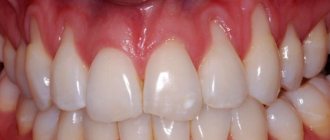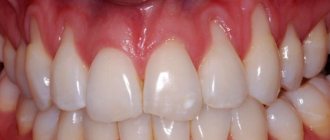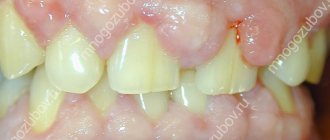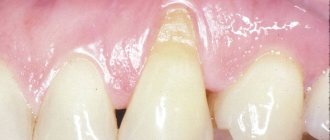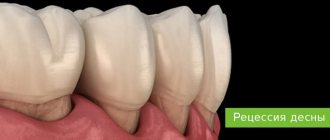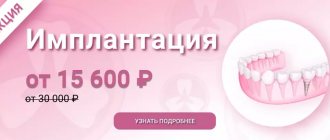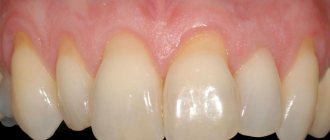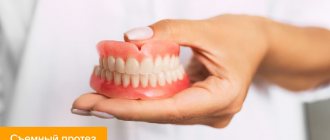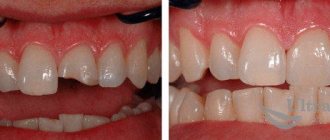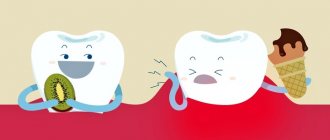Symptoms of pulpitis
- monotonous and aching pain at the initial stage of the disease,
- very strong and acute pain, which worsens closer to night. Unlike ordinary caries, the pain does not decrease, even if the irritant is removed, i.e. stop eating, drinking or brushing your teeth,
- reaction to temperature stimuli - hot and cold, and quite strong and pronounced,
- pain and acute reaction when tapping on the tooth.
Pulpitis is quite difficult to confuse with other diseases precisely because of the specific pain that accompanies the acute course of the disease. As a rule, black carious spots are present on the tooth at the same time, including they can be located under the filling (in this case it becomes dark), as well as under the crown (if the nerve has not been removed, however, in such a situation, carious inflammation will not be visible) .
What does a bare nerve look like?
For some, it is not at all clear what an exposed tooth nerve means. The nerve, or in other words, the pulp, is reliably protected by hard tissues, that is, located under the enamel-dentin layer. This important organ is penetrated by many nerve plexuses, capillaries and vessels. In general, it is he who is responsible for the sensitivity of the tooth, promotes its full blood supply, makes it alive, strong and functional.
Look at the photo below and you will understand what the exposed nerve in the tooth looks like and what it looks like when it is removed from the reamed cavity of the affected element in the dental office. Outwardly, it looks like a bundle, intertwined with pinkish or red threads, with a small round head at the end. It’s not for nothing that it’s called the heart of the tooth. Without it, the full nutrition of hard tissues ceases, so they fade, darken, become fragile and, without additional protection in the form of artificial restorations (inlay, crown), quickly collapse.
Reasons for the development of the disease
- untreated caries or poor quality of filling, when an inflammatory process has developed again under the installed filling,
- preservation of the nerve under the crown - in this case (if the tightness of the prosthesis is broken, there is inflammation underneath) there is a high risk of pulp inflammation,
- tooth injury – inflammation penetrates from the outside, i.e. through cracks and chips that are located on the root or in close proximity to it,
- exposure to aggressive stimuli - temperature and chemical, for example, during previous canal treatment, naturally, with an incorrectly selected dosage of the drug.
How to relieve toothache at home
If toothache is unbearable, medications can help relieve the pain.
- Ibuprofen (Mig-400, Nurofen) - reduces pain after 15 minutes, but does not last long.
- Ketorolac (Ketanov, Ketorol) - a pronounced and long-lasting analgesic effect develops 30-60 minutes after taking the tablet.
- Movalis (Meloxicam) - relieves pain and inflammation, but can cause a burning sensation in the stomach.
- Paracetamol is the safest drug from the NSAID group, approved for children and pregnant women.
- No-spa (Drotaverine) - an antispasmodic enhances the analgesic effect of non-steroidal anti-inflammatory drugs.
- Spasmalgon, Baralgin - analgesics related to Analgin are used as an antispasmodic.
Important! Painkillers are taken strictly according to the instructions, observing the age-specific dosage and frequency of administration. If you do not have the above-mentioned drugs on hand, you can take regular aspirin.
Relief of throbbing pain with medications is supplemented with home remedies:
- cold compress on the cheek
- “mouth baths” (not active rinsing) with sage or chamomile infusions,
- rinsing the mouth with a soda-saline solution (1/3 tsp per glass of lukewarm water),
- apply a cotton wool moistened with eucalyptus oil to the gum,
- chew propolis.
Painkillers will only temporarily relieve pain. Remember that throbbing pain in a tooth is a sign of a disease that necessarily requires treatment. Do not delay your visit to the dentist - the longer the disease develops, the more difficult and expensive the treatment will be.
Sources used in writing the article:
- “Local anesthesia in outpatient dentistry”, Kononenko Yu. G., Rozhko N. M., Ruzin G. P.
- “Modern technologies of local anesthesia in dentistry”, Rabinovich S.A.
- “Emergency conditions in dental practice”, M. Panchishin, I. Got, 3. Masny
Please rate this article
Stanislav Mezheritsky
Chief physician, surgeon, orthopedist
The author of the article is Stanislav Mezheritsky, a practicing dentist with 19 years of experience, chief physician and one of the founders of the Matisse Dent clinic. The main focus is orthopedic and surgical dentistry. Author of numerous publications, regular participant in specialized seminars.
Complications of pulpitis
If you do not consult a dentist in a timely manner, pulpitis can develop into a more serious disease - periodontitis, cyst or granuloma, periostitis. That is, the inflammation will go deeper and go beyond the tooth root. Such complications can lead to tooth extraction, after which neighboring teeth will begin to shift, leading to malocclusion. Since the disease causes some discomfort while chewing food, the patient may face serious gastrointestinal problems.
Medicines
Ledocaine, Ketanov, Indomethacin - first aid against pain from an inflamed tooth nerve.
You can name several of the most popular medications that are used as an anesthetic for inflammation of the dental nerve:
- Ledocaine is a very well-known local anesthetic used in various fields of medicine. To anesthetize the inflamed nerve, apply the drug (gel) to a cotton swab and apply to the affected area for fifteen minutes. If you bought the drug in the form of a spray, then spray about 20 mg on the aching tooth, repeat the procedure every hour and a half, the maximum dose per day is 20 procedures. Before starting treatment with Ledocaine, read the instructions, especially the “Contraindications” section.
- Ketanov , usually widely used in tablet form. Do not exceed the daily dose of 5 pcs. and do not take the drug for more than one week. The greatest effect is when taken before meals. Much superior to the usual Analgin and Indomethacin. The action lasts up to eight hours. There are a number of contraindications.
- Indomethacin is a good pain reliever, taken three times a day; if the effect is not sufficiently pronounced, the dose can be increased to 50 mg. It is better to use after meals and wash down with milk. With prolonged use, exacerbations of chronic diseases are possible. It is advisable to read the instructions carefully before use.
All these drugs will help relieve attacks of severe pain, but do not forget that only a visit to the dental office can relieve you of the disease itself and help avoid possible complications.
Moscow metro station Zvezdnaya, Danube Avenue, 23
Treatment methods
Treatment of pulpitis is carried out in a complex: as a rule, the nerve is removed (only in rare cases, when there is slight inflammation, it can be treated with medication and thereby kept alive for some time). After this, the canals are filled and the coronal part is restored if it is destroyed. Diagnosis and treatment monitoring are necessarily carried out using an x-ray - a targeted image of one tooth.
Dental canal treatment The dental canals are cleaned using special instruments and medications. The treatment takes 2 visits - during the first, the nerve is removed and the cavity is thoroughly cleaned. In the second, the quality of the treatment is assessed, the temporary filling is removed and a permanent one is placed.
Price:
from 4,500 rubles more details about the solution
Installation of a core tab After cleaning the dental canals, if the crown is almost completely destroyed, i.e. under the root, it is necessary to restore the tooth. An inexpensive option is to install a pin, but a more rational option is to make a stump tab that completely replicates the structure of the root system. This way the load is distributed more evenly, so the tooth will last longer. Next, you can install a crown or line the top of the inlay with a composite material.
Price:
from 5,000 rubles more details about the solution
Installing a crown Installing a crown after treatment of pulpitis may be necessary if the apex of the tooth is destroyed by more than half. For the lateral teeth, the best option would be to use metal-ceramics, for the front teeth - pure ceramics. In both cases, a crown made of zirconium dioxide is suitable, since it is characterized by increased strength and at the same time has a snow-white tint. A single prosthesis can be attached to the tooth itself (if there is something left of it), or to a pin or core tab.
Price:
from 11,000 rubles more about the solution
Removal with arsenic
Once upon a time there was only one way to remove it, it was terribly painful, especially since you had to visit the doctor several times. At first, the doctor drilled the tooth down to the pulp with a drill, which was extremely painful. Next, arsenic was placed in the hole and it was temporarily sealed with a filling. In a couple of days, the arsenic dealt with the nerve, and the tooth hurt so much that no medicine could help. Then I had to go to the doctor again, he opened the temporary filling, removed the nerve, and cleaned the root canals. Pulp is a tenacious substance, so this process was also extremely painful.
This technology poses a certain danger, because arsenic is a poison, and the doctor, when using it, must be especially careful, and the patient must be careful: if you are late with the second visit to the doctor and leave arsenic in the tooth, it will completely destroy it, which will end deletion. Dentists stopped using arsenic and developed new techniques for removing pulp.
Prevention
If for some reason you had to depulpate a tooth, you should not think that now it will never bother you again - without proper preventive measures, the likelihood of pain is very high. To avoid complications, follow simple rules:
- Do not eat or drink for 2 hours after surgery - this will reduce the risk of infection under the filling. Smoking and drinking alcohol are not recommended for at least 24 hours after treatment.
- Take anti-inflammatory pain medications as recommended by your dentist.
- At first, try to reduce the chewing load on the pulpless tooth.
- Regular hygiene. Immediately after treatment, buy a toothpaste to reduce tooth sensitivity. In the future, brush your teeth 2 times a day, do not neglect dental floss and mouth rinses.
- Professional hygiene. Visit your dentist at least once every six months. Make an appointment for a professional plaque and tartar cleaning once a year. To protect your teeth from adverse external influences, go through the procedure of fissure sealing, and to strengthen the enamel - remineralization or fluoridation.
And remember - everything in our body is interconnected. Don’t wait for pain – at the first signs of discomfort after dental treatment, contact your doctor immediately.
Author: Elena Kopylova Dentist-therapist, endodontist, pediatric dentist. Work experience more than 7 years. The information is for reference only. Before treatment, consultation with a doctor is necessary.

